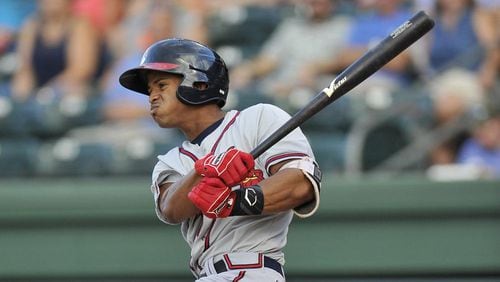LAKE BUENA VISTA, Fla. – Only five players from the little island of Aruba have reached the major leagues, and current Red Sox star Xander Bogaerts is the only one in the since Sidney Ponson last pitched for the Royals in 2009.
It’s not a stretch to say that Braves prospect Ray-Patrick Didder could be the next one.
“He’s got skills,” Braves manager Brian Snitker said.
“He’s a fun guy with a lot of tools,” general manager John Coppolella said.
If you haven’t heard of Didder, that should change before much longer.
Signed as a shortstop in 2013 and soon after switched to the outfield, Didder is a little older (22) than many of the Braves’ top prospects, but that’s because he wasn’t raised in a baseball-intensive locale such as the Dominican Republic, where kids play against elite competition from their early teens and the best are signed at age 16.
Didder signed at age 18 for a mere $20,000, and said he was 5-foot-7 or 5-8 and 140 pounds at the time. “I was playing in big uniforms, because I was so skinny,” he said, smiling. “The uniform was, like, too big for me.”
And, he said, “It’s not like over in the Dominican where you have pitchers throwing 95 (mph). The hardest fastball I’d seen when I signed was 83 miles an hour. In comparison to the Dominican – it’s, like, different.”
He’s 5 feet 11 and 180 now, and his prospect status is in ascend mode.
After growing, maturing and getting up to speed with pro ball during three years in short-season rookie leagues — the Dominican summer league, Gulf Coast League and Appalachian League — Didder arrived at low-A Rome last season and proceeded to bat .274 with nine triples and six home runs while leading all Braves minors leaguers with a .387 on-base percentage, tying for the lead in stolen bases (37), and leading the South Atlantic League in runs scored (95).
The performance moved him into Baseball America’s top-30 Braves prospects at No. 27, in a farm system rated as the best in baseball. And no one will be surprised if Didder moved a lot higher up that list a year from now, after a season spent in high-A and/or Double-A.
He had 32 stolen bases in 109 games from the leadoff spot at Rome, and Didder hit .289 after the All-Star break for a team that got hot in the second half and won the league title. As for toughness, that was evident by the fact the still-slender Didder was hit by 39 pitches — most in all of minor league baseball.
He had three stolen bases in one game and was hit by pitches three times in another.
Although he’s not in major league camp, Didder is among the players who’ve been brought over from minor league camp as extras in some early Grapefruit League games. He’s been in seven games and has six at-bats, his only hit a pinch-hit double.
But if Didder’s spring-training numbers don’t grab attention, his line-drive stroke in batting practice does. And on those back fields, his speed and athletic ability are readily apparent, as is the skill that jumped off the page for Chipper Jones when the legendary former Braves third baseman saw Didder for the first time.
“He’s got an absolute hose,” Jones said, referring to Didder’s throwing arm.
Didder was one of the first couple of names mentioned by Jones after the future Hall of Famer came back from a morning of watching minor leaguers on the back fields recently, in Jones’ capacity as a special assistant in baseball operations.
“He’s an A-plus defender in the outfield,” Jones said. “When I think of him, the first thing I think of is just, smooth. I mean, I was a guy who played the outfield who, when he ran, his head bobbed up and down when he ran. This kid’s head doesn’t move, it allows him to get breaks on balls and cut them off. Obviously he can fly, but probably the most important attribute that he has, or the best attribute that he has, is his arm.
“You look at a guy who’s small in stature, but he’s got an A-plus big-league arm right now.”
The Braves have stockpiled not just elite pitchers in their farm system, but a trio of high-level outfield prospects in 19-year-old Ronald Acuna, Christian Pache (18) and Didder, as well as Dustin Peterson (22), who was competing for a roster spot this spring before breaking the hamate bone in his left hand.
Of course, they also have Gold Glove center fielder Ender Inciarte, who’s signed for six more years. That explains why the Braves have Didder also taking ground balls again at shortstop and second base.
Didder has been brought over for seven Grapefruit League games, and one recent morning he sat quietly at his friend Ozzie Albies’ locker stall, with the stalls of Nick Markakis and Matt Kemp within 10 feet of him on one side and those of Brandon Phillips and rookie sensation Dansby Swanson on the other.
“It’s a great experience, just seeing how the players go about their business, the daily stuff,” Didder said. “It’s a great experience for me.”
He’s a bright guy who picks things up quickly, and it didn’t take Didder long to realize one of the big adjustments that players have to make to succeed at the major league level.
“The game speeds up, but you’ve got to slow it down,” Didder said. “Because it’s the same ballgame. The pitcher’s got to pitch and you’ve got to hit. Same thing when you’re on defense — the game starts when the pitch is pitched. You’ve just got to slow the game down.”
Braves Spring Training






